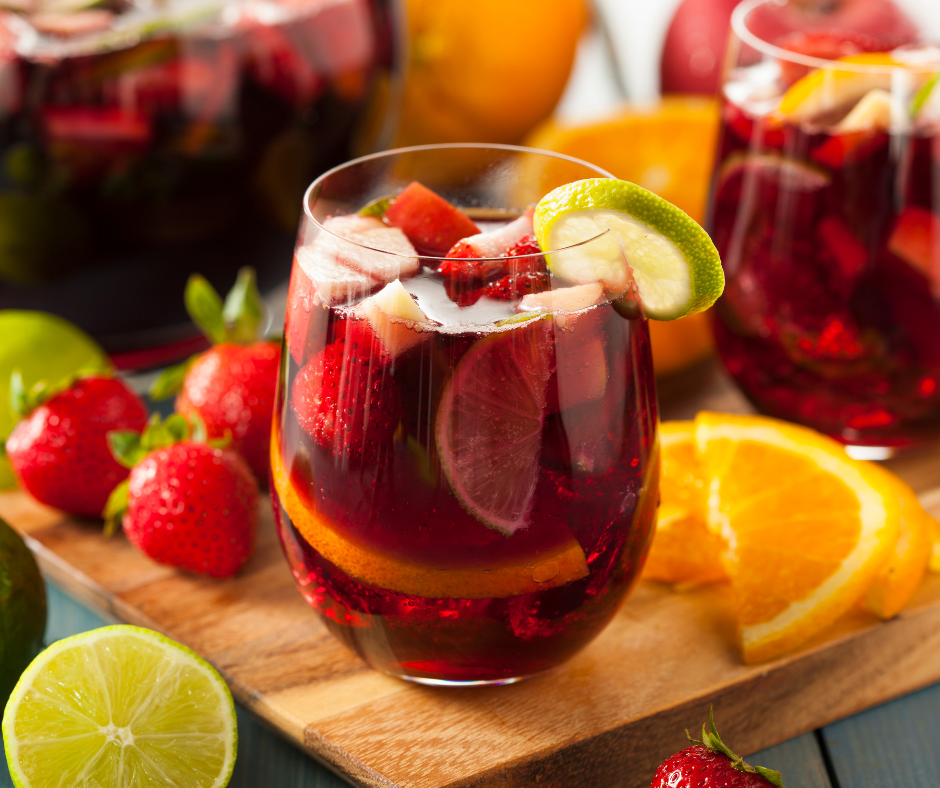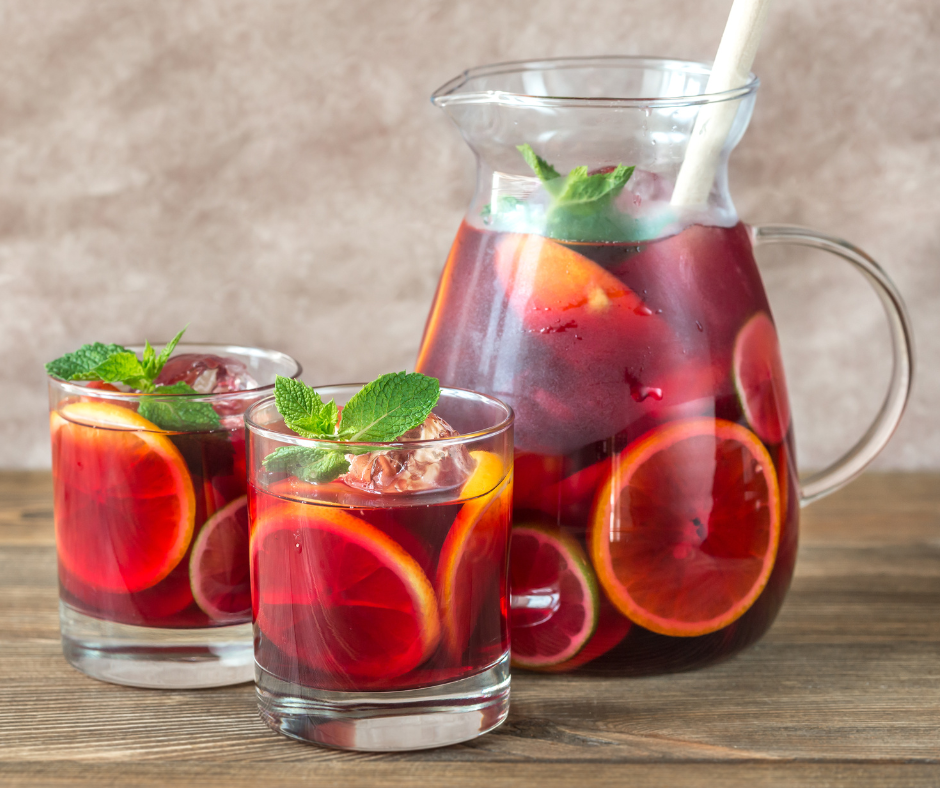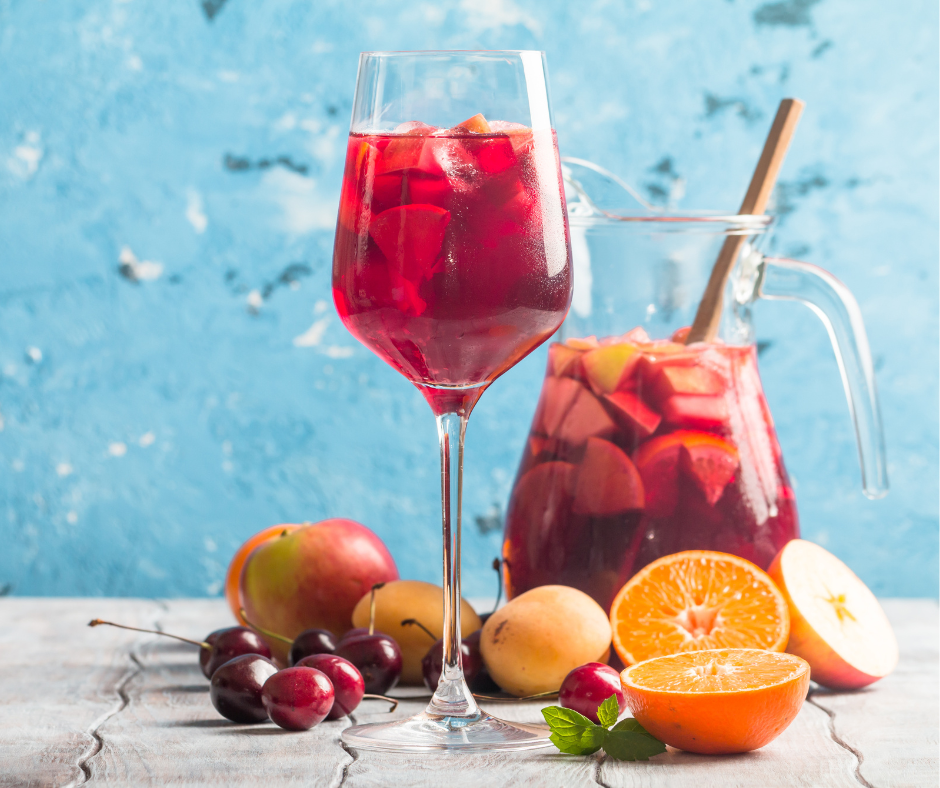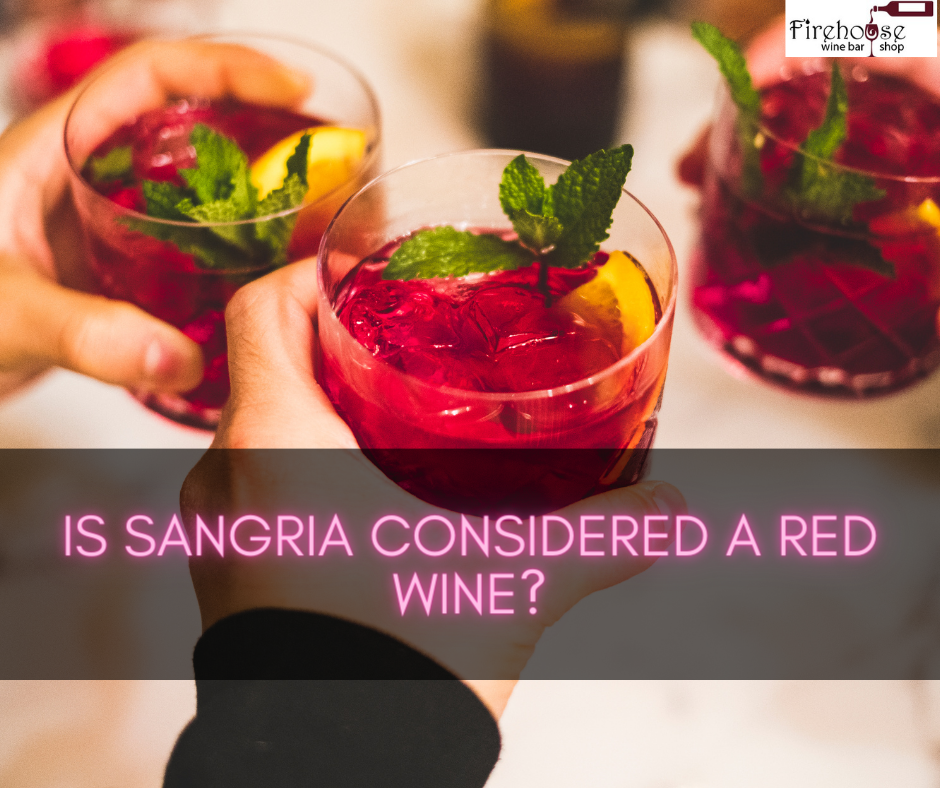Introduction
Sangria is a popular wine-based beverage many enjoy, especially during the summertime. However, Is Sangria Considered a Red Wine? In this section, we will clarify the classification of sangria and shed light on its history and variations.
The History And Origins Of Sangria
The history of sangria dates back centuries, with its origins intertwined with the ancient Greeks and Romans. These civilizations mixed their wine with spices, sugar, and other ingredients to create beverages like hippocras, which served as a more palatable alternative to water. With their rich wine tradition, the Spanish also embraced the concept of wine mixology and developed their own version of this drink.
However, during the rule of the Islamic Moors in Spain from the 8th to the 15th century, the production of sangria faltered. It wasn’t until the Moors were expelled in 1492 that the beverage returned, with wine reintroduced in Spain. Since then, sangria has become an integral part of Spanish culture and has gained popularity worldwide.
The Variations Of Sangria Across Different Regions
Sangria is a versatile drink with countless variations, and its recipe has evolved. Traditionally, red wine, such as Spanish Tempranillo, is used as the base for sangria, hence its association with red wine. However, it is important to note that not all sangria is made with red wine. White sangria is also a popular variation, made with white wine, and there are even sparkling versions of sangria.
The ingredients used in sangria can vary depending on the region and personal preferences. Common ingredients include citrus fruits like oranges and lemons and other fruits like apples, peaches, and berries. Some recipes also call for adding sweeteners like sugar or honey and flavored liqueurs or brandy to enhance the flavor.
The European Union (EU) has established regulations stating that only products made in Spain or Portugal can be labeled as sangria to clarify the classification of sangria. This means that sangria made in other countries must be labeled differently, such as “German sangria” or “Swedish sangria.”
In summary, while sangria is commonly associated with red wine, it is not solely limited to that category. White and sparkling versions of sangria also exist, providing a refreshing twist on this classic beverage. The varying ingredients and regional preferences contribute to the versatility of sangria, making it a beloved drink that people worldwide enjoy.
Whether you prefer a traditional red sangria or like to experiment with different variations, there is no denying that this fruity and flavorful beverage is perfect for warm summer days and social gatherings.

The Key Ingredients Of Sangria
Sangria is a beloved beverage known for its fruity and refreshing flavors. It is commonly associated with Spain and is often enjoyed during summer or at social gatherings. Many wonder, ‘Is Sangria Considered a Red Wine?’ due to its association with varieties of red wine. Let’s clarify the classification of sangria and explore its key ingredients.
The Role Of Red Wine In Traditional Sangria
Sangria is not considered a red wine in itself. Instead, it is a wine-based cocktail incorporating various ingredients, including red wine. Traditional sangria is typically made with red wine varieties such as Tempranillo, Grenache (Garnacha), or Pinot Noir. The red wine adds depth and complexity to the drink, featuring notes of berries, cherries, and other fruity flavors. However, sangria can also be made with white or sparkling wine, depending on personal preference and regional variations.
In traditional sangria recipes, red wine serves as the base and gives the drink a rich color and subtle tannins. The wine is then combined with other essential components to create a harmonious blend of flavors.
Other Essential Components Of The Drink
Aside from red wine, sangria incorporates several key ingredients to enhance its taste and aroma. These may include:
- Fruit: Chopped oranges, apples, lemons, berries, and peaches are commonly added to sangria. The fruit infuses the drink with natural sweetness and vibrant flavors.
- Brandy or Liqueur: Some traditional recipes call for adding brandy or liqueurs like triple sec or Grand Marnier. These spirits add depth and complexity to the drink, complementing the fruit and wine flavors.
- Fruit Juice: Sangria often includes fruit juice like orange juice, which enhances the fruity notes and provides extra sweetness.
- Sweeteners: To balance the flavors, sangria recipes may incorporate sweeteners such as sugar, honey, or simple syrup.
- Carbonated Water: Adding soda or sparkling water gives sangria a refreshing effervescence.
By combining these ingredients, sangria achieves a delightful balance of flavors, blending the character of the wine with the sweetness of the fruits and other complementary components.
In conclusion, while sangria incorporates red wine as a key ingredient, it is not solely considered a red wine. Sangria is a wine-based cocktail featuring various wine varietals, including red, white, or sparkling. Adding fruits, spirits, juices, and sweeteners creates a unique and refreshing drink distinct from a standalone glass of red wine.
So, the next time you’re looking for a refreshing and fruity beverage, consider indulging in a glass of sangria to savor its delightful flavors.
The Classification Of Sangria
Sangria is a popular wine-based beverage originating in Spain and Portugal. It is known for its refreshing and fruity taste, making it a favorite choice for many people, especially during summer. However, there has been some confusion regarding the classification of sangria and whether it is considered a red wine. Let’s clarify the classification of sangria to understand this beloved drink better.
Understanding The Definition And Labeling Laws
Under European Union regulations, sangria can only be labeled as such if produced in Spain or Portugal. This means these two countries have the exclusive right to label their product as “Sangria.” Other regions or countries need to label their similar beverages differently. The regulations also specify the composition and characteristics of sangria, such as using natural citrus-fruit extracts or essences, the addition of spices, and the alcohol content.
Traditional sangria is made with red wine in Spain and Portugal, although white wine variations also exist. The specific fruits, juices, sweeteners, and additional ingredients may vary regionally or based on personal preferences. However, red wine is essential to sangria, giving it its distinctive color and flavor.
Differentiating Sangria From Other Alcoholic Beverages
Sangria is different from red wine itself. While red wine is simply fermented grape juice, sangria incorporates additional ingredients like fruits, sweeteners, and sometimes carbonation. The mixture of these ingredients results in a flavorful and refreshing beverage distinct from a glass of red wine.
It’s important to note that sangria can also be made with white wine, resulting in white sangria. This variation uses ingredients like lemon juice and Sprite, giving it a lighter and citrusy taste. The choice of wine, red or white, determines the overall character of the sangria.
Sangria is a wine-based beverage distinct from pure red or white wine. Its classification is based on Spain and Portugal’s specific production and labeling laws. Sangria is typically made with red wine but can also be made with white wine, offering a range of flavors and options for enthusiasts.
Understanding the classification of sangria helps to appreciate its unique characteristics and its versatility in terms of flavor profiles. Whether you prefer a classic red sangria or a refreshing white sangria, this beloved drink is a popular choice for many individuals seeking a fruity and enjoyable beverage.
The Making Of Sangria
Sangria is a popular wine-based drink that originated in Spain. While it is commonly associated with red wine, some variations also use white wine or rosé. Sangria combines wine, fruit juices, sweeteners, and sometimes brandy or other spirits. It is often served chilled and garnished with fresh fruits.
Step-by-step Guide To Creating A Classic Sangria Recipe
To make a classic sangria, follow these simple steps:
- Choose your wine: Traditionally, sangria is made with Spanish wines such as Garnacha or Rioja. A fruity and bold red wine works best for a traditional sangria recipe.
- Prepare the fruit: Cut up oranges, lemons, limes, and berries. You can add other fruits like apples, peaches, or strawberries depending on your preference.
- Add sweeteners and flavors: In a pitcher, combine the wine, fruit, and sweeteners like sugar, honey, or simple syrup. You can also add spices such as cinnamon or cloves for added flavor.
- Let it chill: Place the pitcher in the refrigerator and let the flavors infuse for at least a few hours, ideally overnight. This will allow the fruit to release its juices and blend with the wine.
- Serve and enjoy: Pour the sangria into ice-filled glasses when ready to serve. Garnish with fresh fruit slices or herbs for an extra touch of presentation.
Exploring Variations And Creative Twists On The Traditional Recipe
While a classic sangria recipe is delicious on its own, you can try endless variations and creative twists. Here are a few ideas to inspire your sangria creations:
- White wine sangria: Instead of using red wine, experiment with white wine or rosé for a lighter and refreshing version of sangria. Pair it with tropical fruits like pineapple and mango for a tropical twist.
- Sparkling sangria: Add a splash of sparkling water or soda to your sangria to give it a bubbly and fizzy texture. This is especially great for summer parties and celebrations.
- Citrus sangria: Focus on citrus flavors by combining oranges, lemons, and limes. You can add a hint of citrus liqueur, like Triple Sec or Cointreau, for an extra kick.
- Sangria spritzer: Mix equal parts of sangria and soda water to create a lighter and more refreshing spritzer. This is perfect for those who prefer a lower alcohol content or a less sweet drink.
Remember, the beauty of sangria lies in its versatility and adaptability. Feel free to experiment with different fruits, wines, spirits, and flavors to create a sangria recipe that suits your taste preferences. Cheers to enjoying this classic Spanish beverage with a creative twist!

The Flavors And Characteristics Of Sangria
Sangria is a popular wine-based drink that originated in Spain. It is typically made with red wine, fruit juices, and brandy. However, some variations use white wine or sparkling wine as the base. Adding chopped fruits such as oranges, apples, and pears gives sangria a refreshing and fruity flavor.
When it comes to the classification of sangria, it is important to note that it is not considered a type of wine. Sangria is a mixed drink incorporating wine as one of its main ingredients. It is a creative and versatile beverage that allows you to customize the flavors and sweetness to your preference.
Tasting Notes Of Red Wine Sangria
Red wine sangria offers a rich and robust flavor profile. The red wine in sangria can vary, but popular choices include Garnacha, Cabernet Sauvignon, Merlot, Rioja, and Shiraz. These wines often have dark berries, plum, cherry, and spice notes, contributing to the sangria’s complexity.
The sweetness of red wine sangria comes from adding fruit juices and sweeteners like sugar or simple syrup. This sweetness balances out the acidity and tannins of the red wine, resulting in a well-rounded and delightful drink. The chopped fruits not only add flavor but also enhance the visual appeal of the sangria.
Comparing The Taste Profiles Of Different Sangria Varieties
While red wine sangria is a classic and beloved choice, other types offer distinct taste profiles. White wine sangria, for example, tends to be lighter and fruitier. It pairs well with citrus fruits like lemons and oranges, creating a crisp and refreshing experience.
Sparkling wine or champagne-based sangria adds effervescence and a touch of sophistication to the drink. The bubbles from the sparkling wine give the sangria a lively and celebratory feel. It is often served on special occasions or as a festive beverage.
Whether you prefer red, white, or sparkling sangria, each variety offers unique flavors and characteristics. Experimenting with different wines, fruits, and sweeteners can help you find your perfect sangria recipe. So gather your favorite ingredients, mix up a batch of sangria, and enjoy this delightful and versatile beverage.
In conclusion, sangria is not considered a type of wine but a wine-based mixed drink that incorporates various ingredients to create a refreshing and flavorful experience. Red wine sangria offers a rich and robust taste, while white wine and sparkling wine variations provide different levels of sweetness and effervescence. Enjoy exploring the world of sangria and discovering your favorite combinations!
Sangria And Health Benefits
The Potential Health Benefits Of Consuming Sangria In Moderation
The popular wine-based cocktail Sangria is often associated with leisurely summer days and social gatherings. But Is Sangria Considered a Red Wine? Let’s clarify the classification of sangria and explore its potential health benefits.
Sangria is not classified as a specific type of wine but rather a mixed drink that typically includes red wine as its base. It combines wine with fruit juices, sweeteners, and sometimes other spirits like brandy or liqueurs. The result is a refreshing and fruity beverage that is enjoyed by many.
The Nutritional Value And Antioxidant Properties Of Sangria Ingredients
While sangria is not a traditional red wine, it still possesses some of the health benefits associated with red wine consumption. Red wine, the main ingredient in sangria, contains antioxidants such as polyphenols and flavonoids that have been shown to protect cells from aging and reduce the risk of certain chronic diseases.
Furthermore, adding fruits like oranges, lemons, and berries to sangria provides additional nutritional value. These fruits contribute fiber, potassium, and vitamins to the beverage. Orange juice, for example, is a good source of vitamin C.
It’s important to note that the health benefits of sangria and red wine consumption are most effective when enjoyed in moderation. The American Heart Association recommends no more than one 5-ounce glass of wine per day for women and up to two glasses for men.
In summary, while sangria is not classified as a pure red wine, it contains many of the health-boosting properties found in red wine due to its base ingredient. Additionally, the fruits added to sangria contribute to its nutritional value. Remember to enjoy sangria responsibly and in moderation to fully appreciate its potential health benefits.
Next, explore some of the most popular sangria recipes and variations you can try for your next gathering!
Pairing Sangria With Cuisine
Sangria is a versatile and popular drink that can be enjoyed with various cuisines. Whether you’re hosting a backyard barbecue or a dinner party, finding the right food pairings can enhance the experience and complement the flavors of your sangria.
Suggested Food Pairings For Different Types Of Sangria
When pairing food with sangria, it’s important to consider the type of sangria you’re serving. Is it fruity or dry? Is it red or white? Here are some suggested food pairings based on the different types of sangria:
- Fruity Red Sangria: This vibrant and sweet sangria pairs well with dishes that have bold flavors and spices. Try serving it with grilled meats, such as chicken or lamb, or spicy Spanish tapas, like patatas bravas or chorizo.
- Dry Red Sangria: A dry red sangria is more subtle in flavor and pairs well with lighter dishes. Consider serving it with a fresh salad, grilled seafood like shrimp or salmon, or vegetarian dishes like roasted vegetables or mushroom skewers.
- Fruity White Sangria: This refreshing and tropical sangria complements a range of flavors. Serve it with dishes with a hint of sweetness, such as glazed grilled chicken or glazed salmon, and fruity desserts like tropical fruit salad or peach cobbler.
- Dry White Sangria: A dry white sangria is crisp and light, making it a great match for lighter dishes. Pair it with seafood like grilled fish or scallops, fresh salads, or light pasta dishes like pesto pasta or lemon garlic linguine.
Highlighting The Versatility And Complementary Nature Of Sangria
Sangria’s ability to complement a wide range of flavors and cuisines makes it so versatile. The fruity and refreshing nature of sangria pairs well with dishes from various culinary traditions. Whether you’re enjoying Spanish tapas, Mexican cuisine, or even Asian fusion dishes, sangria can add a touch of vibrancy to the meal.
Remember, finding a balance between flavors is the key to a successful sangria and food pairing. The fruity and sometimes sweet characteristics of sangria can help balance out spicy or savory dishes, while the acidity and freshness of the drink can cleanse the palate between bites.
So, the next time you’re planning a gathering or simply looking to enjoy a delicious meal, consider adding a pitcher of sangria to the table. It’s versatile nature and complementary flavors make it the perfect beverage to elevate your dining experience. Cheers to a delightful combination of food and sangria!

Is Sangria Considered A Red Wine? – Clarifying The Classification Of Sangria
Sangria is a popular wine-based drink that has its roots in Spain. It is typically made by mixing red wine with fruit juices, brandy, and other ingredients to create a refreshing and flavorful beverage. But Is Sangria Considered a Red Wine? It is important to note that while sangria uses red wine as its base, it is not considered a standalone red wine.
Unlike traditional red wines that undergo fermentation and aging processes, sangria is a mixed drink that combines wine with various additional components to enhance its taste and appeal. Adding fruit juices and other ingredients gives sangria its unique flavor profile and makes it an ideal choice for those looking for a fruity and refreshing drink.
Sangria is classified as a cocktail rather than a standalone red wine. It offers a fun and creative twist to traditional red wine by infusing it with vibrant flavors and aromas. It is often served chilled and enjoyed as a refreshing beverage, especially during warm summer or outdoor gatherings.
While sangria is typically associated with red wine, it is worth mentioning that there are also variations that use white wine or rosé as the base. The choice of wine depends on personal preferences and desired flavor profiles. White wine sangria tends to be lighter and more citrus-focused, while red wine sangria offers richer and more robust flavors.
In conclusion, while sangria uses red wine as its base, it is not considered a standalone red wine. It is a cocktail that combines red wine with fruit juices, brandy, and other ingredients to create a refreshing and flavorful beverage. Sangria offers a unique and enjoyable twist to traditional red wine, making it a popular choice for those seeking a fruity and refreshing drink.
FAQ: Is Sangria Considered a Red Wine? – Clarifying the Classification of Sangria
Q: What is sangria?
A: Sangria is a popular Spanish drink made with wine, fresh fruit, liquor, and sometimes a sweetener. It is often served chilled and is known for its fruity and refreshing taste.
Q: Is sangria considered a red wine?
A: No, sangria is not considered a red wine. Sangria is a mixed drink that typically incorporates red wine as one of its main components. While red wine is a key ingredient in traditional Spanish-style sangria, sangria is a separate drink that can be made with various types of wine, including white or rosé.
Q: What are the main components of traditional sangria?
A: Traditional sangria generally requires fruit (such as apples and oranges), orange juice, a sweetener (such as brown sugar or cane sugar), a liquor (such as brandy or rum), bold fruity dry Spanish red wine (such as Tempranillo, Garnacha, or other Rioja wine), and ice for chilling. These ingredients combine to create the refreshing and flavorful characteristics of sangria.
Q: Can I use a different type of liquor in sangria?
A: Yes, you can experiment with different types of liquor based on your preferences. While brandy is commonly used in traditional sangria recipes, you can also use rum or other spirits to add your desired flavor profile to the drink.
Q: Is sangria suitable for year-round entertaining?
A: Absolutely! While sangria is often associated with summer, the use of red wine in this recipe makes it a great choice for year-round entertaining. The sweet yet balanced flavors and the addition of fresh fruits make sangria enjoyable in any season.
Q: What type of red wine should I use for sangria?
A: It is advisable to use a fruity, dry red wine that is slightly acidic and low in tannins for sangria. Spanish red wines like Tempranillo, Garnacha, or other Rioja wine varieties are traditionally used, but you can also explore other wine options based on your personal taste preferences.
Q: Where can I find a recipe for making red sangria?
A: There are various websites and blogs that offer red sangria recipes. You can search online for recipes from trusted sources like Minimalist Baker Recipes, Love and Lemons, or other reputable food websites to find step-by-step instructions on making delicious red sangria.
Conclusion
Sangria is a popular and refreshing alcoholic beverage often associated with summer gatherings and outdoor events. It is typically made with red wine and mixed with various fruits, juices, and sweeteners. However, there may be some confusion about ‘Is Sangria Considered a Red Wine?’. Let’s take a closer look at the classification of sangria to clarify any misconceptions.
Sangria combines red wine with other ingredients such as brandy, fruit juices, and sugar. This mixture is then typically served chilled or over ice. While the main component of sangria is red wine, it is important to note that it is not classified as a type of wine. Instead, it is considered a wine-based cocktail, as it involves the addition of other ingredients to enhance its flavor profile and create a unique and refreshing beverage.
To better understand the classification of sangria, it is essential to distinguish between wine and wine-based cocktails. Wine is an alcoholic beverage produced through the fermentation of grape juice. It can be made from various types of grapes and comes in various flavors, colors, and styles. On the other hand, sangria is a cocktail that incorporates wine as its base ingredient but includes additional elements to create its distinct taste.
While sangria is typically associated with red wine, it is worth mentioning that it can also be made with white wine. White sangria is created using a similar process, substituting white wine instead of red. This variation offers a lighter and fruitier taste profile than traditional red sangria.
In summary, sangria is not classified as a type of wine but a wine-based cocktail. It combines red or white wine with other ingredients to create a refreshing and flavorful beverage. Sangria is a popular choice for those seeking a delightful and vibrant drink made with red or white wine.
Summarizing The Classification And Importance Of Sangria
To summarize, sangria is not considered a type of wine but a wine-based cocktail. It combines red or white wine with various fruits, juices, and sweeteners to create a refreshing and flavorful beverage. Sangria offers a unique and enjoyable drinking experience for social gatherings and celebrations.

Andre Lotz immigrated to the United States from South Africa almost 20 years ago. Still, he didn’t feel truly at home until he settled in Mobile—a city that reminds him of his childhood home of Fish Hoek on the southern cape of Africa.

